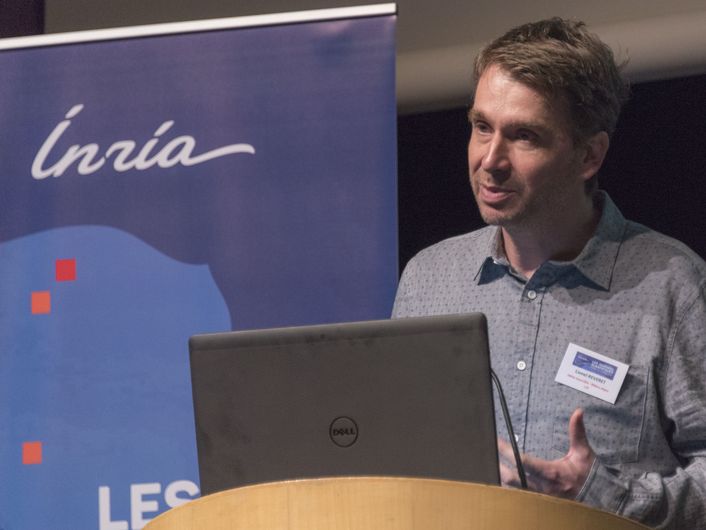Lionel Reveret is an Inria researcher at the Grenoble Rhône-Alpes centre. His research deals with different aspects of motion capture, with a range of links to other disciplines such as 3D animation, biology and biomechanics. The primary focus of his research is now turned towards top-level sport as the country gears up towards the Olympic Games in Paris in 2024.
Lionel, could you tell us about your collaboration with TSF Voiron and France’s Olympic Rock-Climbing Centre ?
TSF Voiron is a workers’ cooperative that took over from CREPS Rhône-Alpes, housing top level athletes and giving them access to the very latest sporting equipment. A number of sports are involved, including France’s Olympic Rock-Climbing Centre. They work with all rock-climbing disciplines, with a 22m lead climbing wall, a 17m international format speed wall and a brand new bouldering room, which was opened in 2018.
What makes this collaboration original is the dedicated research space that has been opened up on the premises of TSF Voiron, enabling staff, students, researchers and engineers to come and work directly with athletes and coaches on-site. An agreement was reached between TSF Voiron, Inria, the CNRS and Grenoble Rhône-Alpes University in order to make this happen.
How is virtual reality incorporated into training in rock climbing ?
When it comes to rock climbing, our primary focus is on augmented reality, where information is superimposed over reality in order to illuminate that reality virtually. Generally speaking, our work involves video analysis of sporting movements, where a 3D avatar of the athlete (developed in the laboratory) is aligned directly over the video of their performance in order to view and objectively measure the posture of their body in real-life performance situations.
So how is this data acquired, especially in speed climbing ?
In the context of competitive climbing, conventional motion capture technology using markers cannot be deployed on a daily basis. What this means is that we regularly use video, ordinarily using a tablet but sometimes using drones. On the whole, video analysis is informative, but it remains subjective.
Developing a 3D method, incorporating multiview technology, has meant we are able to objectively measure biomechanical markers, figures illustrating consistency or improvement in performance. This gives coaches an additional tool to assist them with their work, enabling them to supply athletes with feedback on the motor function of their entire body.
How is the data that is acquired then used to improve athletes’ performance ?
Objective measurements of motor function and motion dynamics are then converted into curves and graphs. Initial feedback is the coach’s responsibility. This data can then be used in statistical processing in order to track long-term athlete performance.
On the subject of augmented reality, it is also worth noting that the type of data extracted can be used in conjunction with video through original viewings. This is an area that we find particularly interesting, and one which we have started to explore with the INSEP and our colleagues from Inria.
Why acquire data in the lab and not in the field ?
More accurate data can be accessed in the lab. We use Kinovis from the Inria Grenoble Rhône-Alpes centre to develop biomechanical models and 3D avatars of athletes in order to quantify the basic aspects of their motor function. However, actually playing sport in real life involves different kinds of movements, central to the reality of performance, and which can only be learned on-site. The laboratory and the field are fully complementary: by using the lab’s equipment, we are able to compile a biomechanical model of an athlete in a 3D avatar, which is then used as an analysis guide for the video data obtained in the field through machine learning.
What difficulties are there when it comes to working with top athletes ?
Athletes and coaches have extremely tight schedules, with global competitions coming in quick succession across the world. This is what we find most difficult - the availability of top athletes. With that in mind, it is essential to build a relationship of trust with coaches in order to ensure responsive communication and to make sure that we are able to adapt quickly to their busy schedules of competitions and training sessions. One other important point to bear in mind is that athletes need to be able to concentrate fully on what they’re doing, meaning any technical instruments have to be as transparent as possible so as not to affect the athlete in any way. This focus on discretion has an impact on the way we work, giving us an additional challenge to tackle.
This year you’ll be participating at the Sport Unlimitech expo - what do you think you will get out of participating at this type of expo ?
This is the first time this event will be held, but the programme contains everything that motivates me: science, field innovation and top-level sport. I will be attending sessions with all national stakeholders with an interest in this coming together between research and sport, which seems to be really developing at the moment.
